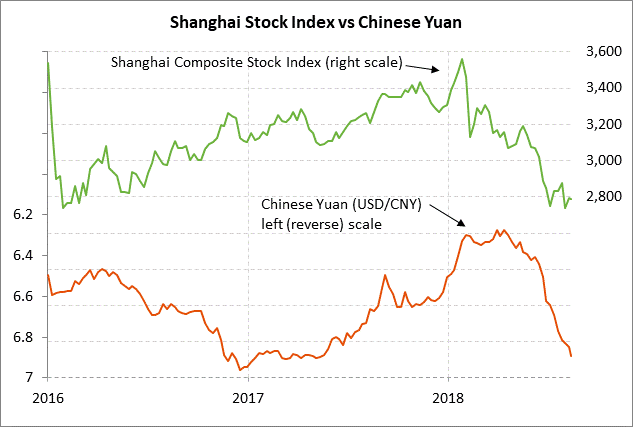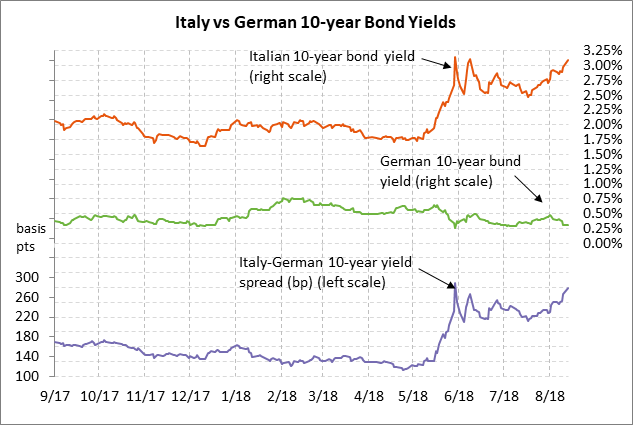- Markets start to absorb the Turkish crisis
- U.S. import prices expected to remain strong
Markets start to absorb the Turkish crisis — The Turkish lira (USD/TRY) on Monday fell to another new record low and closed the day -8.02%, adding to last Friday’s plunge of -15.88%. The lira has now plunged by -41% this month and by -83% year-to-date, which certainly qualifies as a full-fledged currency crisis. The iShares Turkish stock ETF (TUR) plunged by another -11.0% on Monday, adding to last week’s plunge of -20.6%.
The markets on Monday were disappointed that the Turkish central bank refused to raise its policy interest rate from the current level of 17.75%, which is the only sure-fire way to halt the currency crisis. The Turkish central bank on Monday did at least ease bank reserve requirements to expand lending liquidity and also eased bank rules for managing lira and foreign-currency liquidity. Those measures slowed the lira’s decline.
The lira would likely get a temporary reprieve if the Turkish central bank would raise interest rates or if the U.S. drops its sanctions if Turkey releases the American pastor. However, Turkey is suffering from deep-seated problems including high inflation, a large current account deficit, inadequate foreign currency reserves, and very high dollar-denominated debt levels. Therefore it will likely take a series of interest rate hikes to convince the markets that the Turkish government is serious about tackling inflation and supporting its currency. There is little prospect of that happening with President Erdogan’s current wrong-headed approach to managing the economy, inflation, and the lira.
As things stand now, President Erdogan effectively controls the Turkish central bank and he is dead set against interest rate hikes. There is room for the crisis to get much worse if President Erdogan does not accept the necessary remedies. If the crisis continues, the Turkish government may have to impose capital controls and may even have to succumb to an IMF bailout with painful and humiliating pre-conditions.
The Turkish crisis on Monday sparked substantial contagion to other emerging markets and at least some contagion to developed markets. The iShares Emerging Markets Index (EEM) on Monday fell by -1.64% to a new 1-1/2 month low, adding to last week’s -2.31% sell-off and nearly challenging June’s 1-year low. The WisdomTree Emerging Currency Fund (CEW) fell by -1.60% on Monday to a new 1-1/2 year low and added to last week’s -2.47% sell-off.
Meanwhile, in the developed markets, the S&P 500 index on Monday fell by only -0.40% and the Euro Stoxx 50 index fell by only -0.48%. Japan’s Nikkei index, by contrast, plunged by -1.98% on Monday, adding to last Friday’s -1.33% loss.
EUR/USD on Monday fell to another new 13-month low although it recovered and closed the day little changed. EUR/USD is being hit by the Turkish crisis due to the exposure of some European banks to Turkish debt and due to concern about contagion for the already-shaky Italian markets.
Indeed, the Italian 10-year bond yield on Monday rose by another +11 bp to 3.10%, which was just 6 bp below May’s 4-1/4 year high of 3.16%. The spread of the 10-year Italian yield over the German bund yield on Monday rose by another +11 bp to 279 bp, which is up 45 bp since July and is just 11 bp below May’s 5-year high of 290 bp.
The Italian bond yield is rising due to the exposure by some large Italian banks to Turkish debt and due to ongoing concern about the Italian populist government’s apparent intent to bust its 2019 budget and break EU budge rules.
U.S. import prices expected to remain strong — The market consensus is for today’s July import price index to be unchanged m/m and +4.5% y/y, which would be stronger than June’s report of -0.4% m/m and +4.3% y/y. Ex-petroleum, today’s July import price index is expected to show a small gain of +0.1% m/m after June’s -0.3% decline.
Today’s expected July import price report of +4.5% y/y would be just 0.2 points below the 6-year high of +4.7% posted in Feb 2017 and would be more than double the Fed’s inflation target of +2.0%.
U.S. import prices are seeing upward pressure from strong energy prices and from new tariffs on U.S. imports. The Trump administration has so far slapped tariffs on lumber imports from Canada, solar equipment imports, washing machine imports, steel and aluminum imports, and $34 billion worth of various Chinese products (with $16 billion more coming on Aug 23). Import prices are rising despite the downward pressure seen from this year’s rally in the dollar index to a 14-month high.
The strength in imports is putting upward pressure on the overall U.S. inflation statistics and is keeping the pressure on the Fed to continue its rate-hike regime. The U.S. CPI rose to a 6-1/2 year high of +2.9% in June-July and the core CPI in July rose to a 10-year high of +2.4%. The PCE deflator rose to a 6-1/4 year high of +2.2% y/y in May-June and the June core PCE deflator of +1.9% y/y was just 0.1 point below March’s 6-1/4 year high of +2.0%.
Meanwhile, the market is discounting a 100% chance of a Fed rate hike at its next meeting on Sep 25-26. The market is then discounting a 70% chance for the Fed’s fourth rate hike of the year at the Dec 18-19 FOMC meeting. The market is then discounting another 36 bp of rate hikes in 2019, bringing an end to the Fed’s rate-hike regime with the funds rate settling near 2.65% by late 2019.


